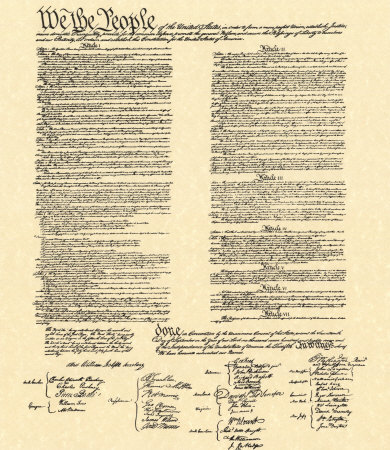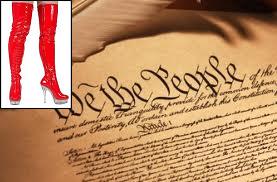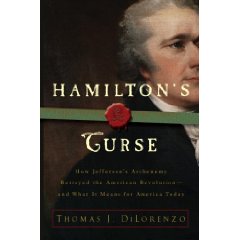There is currently a movement in the United States that is gaining a disturbing momentum. The leaders of the movement are agitating state governments to petition Congress to call a new constitutional convention. While groups on the left have been demanding a new convention for the purpose of re-writing the existing Constitution for decades the current calls are coming from groups that most would place in the “conservative” category. The liberal groups are calling straightforwardly for a convention with plenipotentiary constitution making authority while the conservative elements are calling for a convention limited by charter for the purpose of amending the existing Constitution. While the latter sounds reasonable it is the opinion of the Institute For Principled Policy, not on our own authority but based on extensive research on the legal, historical, and procedural precedents set by conventions of the United States, colonial America, and Great Britain, that the chartering of a so-called controlled or “shackled” constitutional convention will have the same result as the calling of a convention with plenipotentiary authority. That predicted result in either case is a new constitution. Based on further research into existing constitutional models, parts which are already being implemented, we believe that the government created by any new constitution will be divorced from both the bedrock philosophical moorings laid out in the Declaration of Independence and from the shackles imposed by the current constitution. In this light the Hegelian Dialectical nature of the debate over a new constitutional convention is exposed.
In this series we will present the case and documentation that are the foundation our positions.
_______________________________________________________
 About once a decade or so, over the last 40 years, a group of social activists decides that a new constitutional convention would be a good idea for one reason or another. The 2010’s have proven to be no exception. What is exceptional about the early 2010’s is that there is a looming governmental and economic crisis that could conceivably provide the “tipping point” necessary for a new convention. In the past, issues like the so-called “Fair Tax,” immigration reform, a balanced budget amendment, state sovereignty (already covered in the 9th and 10th amendments to the Constitution) and a host of others, one group has a list of 10 proposed amendments, have been used as motivating issues. Up to this point, none of these issues, taken singly, have had the horsepower necessary to create the political pressure necessary to trigger a serious call for a constitutional convention.
About once a decade or so, over the last 40 years, a group of social activists decides that a new constitutional convention would be a good idea for one reason or another. The 2010’s have proven to be no exception. What is exceptional about the early 2010’s is that there is a looming governmental and economic crisis that could conceivably provide the “tipping point” necessary for a new convention. In the past, issues like the so-called “Fair Tax,” immigration reform, a balanced budget amendment, state sovereignty (already covered in the 9th and 10th amendments to the Constitution) and a host of others, one group has a list of 10 proposed amendments, have been used as motivating issues. Up to this point, none of these issues, taken singly, have had the horsepower necessary to create the political pressure necessary to trigger a serious call for a constitutional convention.
The concept of the “tipping point,” a rapid and pivotal change in public opinion or the opinion of key players at critical points of history that occur prior to and which drive key historical events1, is a crucial concept in the history of the Constitution. The number of constitutional conventions held in the United States is small, only one so far, but the histories of the convention are voluminous. And, sadly, much of what is written in these histories is wrong, based on the writings of those who were diligently working to create a shift in public opinion and were not above a healthy dose of propaganda to create a “tipping point” in favor of replacing the confederated government of the Articles of Confederation with a new, “national” government which would eliminate the states as sovereign entities. After working for years to undermine the authority and effectiveness of the Articles of Confederation, nationalists (those in favor of a new national government) in Massachusetts, found their state embroiled in a crisis, which if sold properly, could be used to mold public opinion and the opinions of key players like George Washington into demanding a new constitutional convention. Men like Henry Knox, Benjamin Lincoln and other former members of Washington’s Continental Army staff, many of them members of the society of the Cincinnati, began writing exaggerated and inflammatory accounts of the events of Shays’ rebellion to key players in Congress, the press and George Washington. Thus Shays’ Rebellion, a local crisis based on a failure of the Massachusetts state government to redress the grievances of its citizens, was turned into an embryonic popular revolt that “threatened to spread across state lines” using carefully constructed accounts of the events that created something of a panic. These were all but a complete fiction. And yet the evidence of this has only been chronicled in any detail in the early 21st century by a scholar who discovered that his university was in possession of the official archives of the rebellion and decided it was time for a fresh look at the data. What he discovered was that the generally accepted accounts of the rebellion don’t match the events painted by the official records. History truly is in the hands of the victors.
The question we must ask in light of this information is, can something similar happen in our time? Are there individual or groups who want a fundamental change in our form of government and are they willing to exploit a crisis or create one to achieve the goal? Secretary of State Hillary Clinton, a progressive product of 1960’s radicalism, demonstrated that her training was not wasted. “Never waste a crisis” she told the European Union when speaking on global climate change and the global economic meltdowns (speaking of created crises). [youtube]http://www.youtube.com/watch?v=B62igfNu-T0[/youtube]Clinton knows history. She knows that no radical change to government is possible except as a reaction to some crisis that is perceived as having no existing remedy that  requires quick and decisive action. Thus the quote attributed to James Madison- “Crisis is the rallying cry of the tyrant”- is demonstrated to be an important insight, whether or not Madison actually said or wrote it.
What if a “perfect storm” of concern and outrage over a combination of two or more of the “hot button” issues from the list above or some other societal problems begins to gain momentum? What about a complete economic collapse? What about more “Obamacare” or bank/financial bailout type situations? Do people really understand that the problem with our current government lies not in its structure but in the fact that its limits as outlined in the Constitution, the highest law of the land, are repeatedly ignored or directly flouted by the very people they return to office election cycle after election cycle? Do people who should, really understand the ins and outs of a new constitutional convention or have the waters regarding the first convention, what happened there and what those precedents mean for a new convention been too muddied by historical revisionism and malignant neglect? Or have those events been clouded by a fog of general ignorance of the history and causes of the first convention in combination with deliberate efforts to obfuscate them?
In that vein, are you able to spot both the drum beat of crisis and the fatal problems with this “model resolution” calling for a “shackled” constitutional convention for one purpose and one alone?
Federal Relations Working Group Resolution on Article V of the U.S. Constitution2
Whereas the growth of federal government power at the expense of states has accelerated in recent years; and Whereas limiting the continued unchecked growth of federal power may require Constitutional reform; and
Whereas Congress is unlikely, without outside encouragement to propose any Constitutional Amendment that limits its own power; and
Whereas two-thirds of the states should have the same power to propose individual amendments to the Constitution for ratification as does two-thirds of Congress; and
Whereas when state legislators understand that legal and political procedures could limit an Article V Convention to the consideration of just one amendment, the balance of power between the federal and state governments would be fundamentally altered;
Therefore be it resolved that the American Legislative Exchange Council (ALEC) support and facilitate the education of state legislators about how an Article V Convention called by state legislatures could be reliably limited to an up or down vote on the text of a single amendment to the U.S. Constitution, including the possibility of an amendment that would give two-thirds of the states the explicit right to propose amendments without having to obtain the consent of Congress;
Therefore be it further resolved that ALEC facilitate times for legislators interested in working on this issue in more detail to meet during future ALEC meetings and events.
The drumbeat of the crisis is readily evident . But did you find the far more subtle problem in the “Whereas’s?” It’s there and it’s big. But don’t feel bad if you can’t find it. Most can’t. That’s because there has been so little effort put into teaching the Constitution, how it works and it’s history in primary and secondary education. Colleges, aside from a few isolated outposts of original intent thought teach a dreadfully deconstructed version of the events surrounding its development, how it’s supposed to function and the document itself. That’s why this series is being written.
Since many don’t know the history leading up to and during the Philadelphia Convention in 1787 we’re going to walk through some of the high points (and some of the low) and point out where there has been unintentional and where there has been deliberate blurring of those events. Some of the history isn’t pretty and some readers will find that founders they had looked at almost as demi-gods will emerge as men of much lower stature, men of great ability who sometimes used their God-given talent to further their own, sometimes less than lofty goals and ends. This is not necessarily a bad thing. Deification of men, no matter their historical importance and personal abilities is a dangerous matter. We will also expose some rather gaping flaws in the Constitution. This will challenge the beliefs of some who believe the Constitution is a Divinely inspired document handed down in revelatory style, on par with the Bible. It will also challenge those adherents to the American civil religion, the First Church of the United States, wherein American citizenship somehow automatically rates a free trip through the Pearly Gates as long as the holy sacraments are received by the congregants.
Don’t misunderstand; the Constitution is a brilliantly written document and is unequaled in history. It has some glaring mistakes, something that is to be expected of a document written by men with different backgrounds, motivations and viewpoints. It is marvelous, eloquent, flawed and in modern political discourse bantered about for public consumption but mostly ignored by the men and women we have charged with a solemn oath to uphold and defend it.
And most of all, it needs to be preserved, defended and protected from those who would like nothing better than to replace it with governing documents that will disconnect our government from its Christian philosophical foundation and radically redistribute power and wealth and alter American society.
This series will be comprised of 3 parts. Part I is a historical examination of the series of crises that resulted in the Philadelphia convention in 1787. Part II will be an examination of what is happening today to create or use existing crises to gin up a public cry for a new convention. In the final section we will expose existing plans, already partially implemented as part of the existing system of government, much of it in violation of the current Constitution, just waiting for the exploitation or creation of the level of crisis necessary to create the “tipping point” for a new constitutional convention.
___________________________________________________________________________________
1 Gladwell, Malcolm The Tipping Point: How Little Things Can Make A Big Difference; Little, Brown, and Co., Boston, 2002, rear cover, “The tipping point is that magic moment when an idea, trend, or social behavior crosses a threshold, tips, and spreads like wildfire”
2 American Legislative Exchange Council Resolution Passed by the International Relations Task Force and Federal Relations Working Group on December 4, 2009. Approved by the ALEC Board of Directors on January 8, 2010







